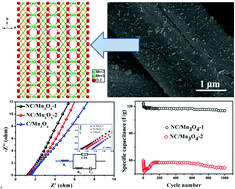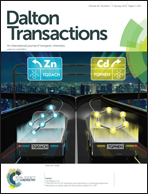High nitrogen-doped carbon/Mn3O4 hybrids synthesized from nitrogen-rich coordination polymer particles as supercapacitor electrodes†
Abstract
High nitrogen-doped carbon/Mn3O4 composites were synthesized by annealing nitrogen-rich Mn-based coordination polymer particles, and investigated by electron microscopy, X-ray diffraction, and electrochemical experiments. To assess the performance of high nitrogen-doped hybrids as electrode materials in supercapacitors, cyclic voltammetry and galvanostatic charging–discharging measurements are performed. High nitrogen-doped carbon/Mn3O4 composites are charged and discharged faster and have higher capacitance than carbon/Mn3O4 nanostructures with low nitrogen amounts and other reported ones. The capacitance of the high nitrogen-doped carbon/Mn3O4 is 94% retained after 1000 cycles at a constant current. These improvements can be attributed to the nitrogen-doped carbon matrix, which promotes fast Faradaic charging and discharging of the Mn3O4 motifs. The nitrogen-doped carbon/Mn3O4 composites could be a promising candidate material for a high-capacity, low-cost, and environmentally friendly electrode for supercapacitors.


 Please wait while we load your content...
Please wait while we load your content...